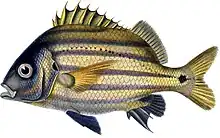Brownstriped grunt
The brownstriped grunt (Anisotremus moricandi), also known as the burro, is a species of marine ray-finned fish, a grunt belonging to the family Haemulidae. It is native to the western Atlantic Ocean.
| Brownstriped grunt | |
|---|---|
 | |
| Scientific classification | |
| Domain: | Eukaryota |
| Kingdom: | Animalia |
| Phylum: | Chordata |
| Class: | Actinopterygii |
| Order: | Perciformes |
| Family: | Haemulidae |
| Genus: | Anisotremus |
| Species: | A. moricandi |
| Binomial name | |
| Anisotremus moricandi (Ranzani, 1842) | |
| Synonyms[2] | |
| |
Description
The brownstriped grunt has a deep and compressed body with a blunt head with the mouth positioned low. The mouth is small with fleshy lips and bands of teeth on the jaws, the outer band of teeth being conical in shape. The dorsal finis continuous but has a deep notch. This fin contains 12 spines, the 4th spine being the longest, and 15-17 soft rays. The anal fin has 3 spines, the second being very large, and 9 soft rays. [3] The background colour of the body is dark brown and there are 5-6 cream to yellow horizontal stripes. The paler stripes may be broader or narrower than the dark stripes. The caudal peduncle has a black blotch and it has two small saddle spots on its upper caudal part in juveniles which fade as the fish matures. The head is dark brown with a large vertical whitish area on the gill cover. There is a pair of pale stripes below eye and a dark blotch on the rear of the gill cover. The pelvic fins are dark brown the other fins being a paler brown.[4] This species attains a maximum total length of 15 cm (5.9 in).[2]
Distribution
The brownstriped grunt is found in the tropical Western Atlantic Ocean. It has a discontinuous distribution. It occurs from the Caribbean coast of southern Costa Rica to Santa Marta in Colombia, from Curacao to the Gulf of Paria off Venezuela and off northeastern Brazil where it is found from Sao Luis to Espírito Santo.[1]
Habitat and biology
The brownstriped grunt is found on shallow rocky reefs in coastal waters, preferring turbid continental coasts rather than islands. It is mainly nocturnal hiding during the day in crevices. It is found in small groups or as solitary fish. It feeds on benthic invertebrates and some filamentous algae.[5]
Systematics
The brownstriped grunt was first formally described in 1842 as Haemulon moricandi by the Italian catholic priest and naturalist Camillo Ranzani (1775-1841) with the type locality given as Brazilian seas. Some authorities treat this species as being the only member of the monospecific genus Paranisotremus.[6] The specific name honours Moïse Etienne (Stéfano) Moricand (1779-1854), who was treasurer and secretary of the Geneva Natural History Museum and who donated a collection of fish specimens from Brazil to that museum.[7]
Utilisation
The brownstriped grunt is nota target for commercial fisheries, it may be caught by artisanal fisheries in some parts of its range. It occasionally appears in the aquarium trade.
References
- Anderson, W.; Claro, R.; Cowan, J.; et al. (2017) [errata version of 2015 assessment]. "Anisotremus moricandi". IUCN Red List of Threatened Species. 2015: e.T1308A115056181. doi:10.2305/IUCN.UK.2015-4.RLTS.T1308A512141.en. Retrieved 21 March 2021.
- Froese, Rainer; Pauly, Daniel (eds.) (2019). "Anisotremus moricandi" in FishBase. April 2019 version.
- "Species: Anisotremus moricandi, the Burro". Shorefishes of the Greater Caribbean online information. Smithsonian Tropical Research Institute. Retrieved 21 March 2021.
- "Anisotremus moricandi". WesternAtlanticFish.com. Retrieved 21 March 2021.
- Thelma Lúcia Pereira Dias (2007). "What do we know about Anisotremus moricandi (Teleostei: Haemulidae), an endangered reef fish?". Biota Neotropica. 7 (2): 317–319. doi:10.1590/S1676-06032007000200037.
- Eschmeyer, William N.; Fricke, Ron & van der Laan, Richard (eds.). "Species in the genus Paranisotremus". Catalog of Fishes. California Academy of Sciences. Retrieved 21 March 2021.
- Christopher Scharpf; Kenneth J. Lazara, eds. (5 January 2021). "Order LUTJANIFORMES: Families HAEMULIDAE and LUTJANIDAE". The ETYFish Project Fish Name Etymology Database. Christopher Scharpf and Kenneth J. Lazara. Retrieved 21 March 2021.
